Extremes: Life, Death and the Limits of the Human Body
 Kevin Fong
Kevin Fong
Hodder & Stoughton, £8.99
Here is a series of reminiscences on the extremes that the human body can survive, written by someone trained both in space science and medicine. It's a racy read, but not a satisfying one. Early on, it tells the story of the skin with a detailed list of its functions, but excluding the repair and regeneration mechanisms and omitting salt excretion – both crucial. We are told that the skin can resolve points little more than 1mm apart, although the standard teaching is that, even on the lips, the distance separating two points between which we can discriminate is more like 3mm, while elsewhere on the body it is closer to 40mm.
The book reminds us of two New Zealand doctors: Harold Gillies, who pioneered reconstructive surgery with the walking stalk; and Archie McIndoe, who revolutionised plastic surgery. It then moves on to details of a face transplant in 2011, although without any comment on the first partial transplant in France (2005), and mentioning the first full face transplant in Spain (2010) only as an afterthought.
In the end, it is the records that remain in the mind: free-diving by an Austrian down to 214 metres, the Frenchman who can hold his breath for 11 minutes, the Russian in orbit for 437 days, and a Norwegian surviving in the Arctic without a heartbeat for three hours.


